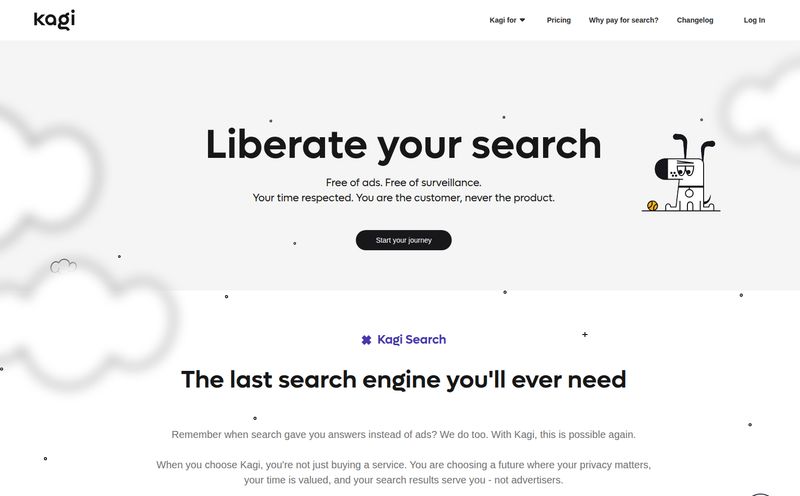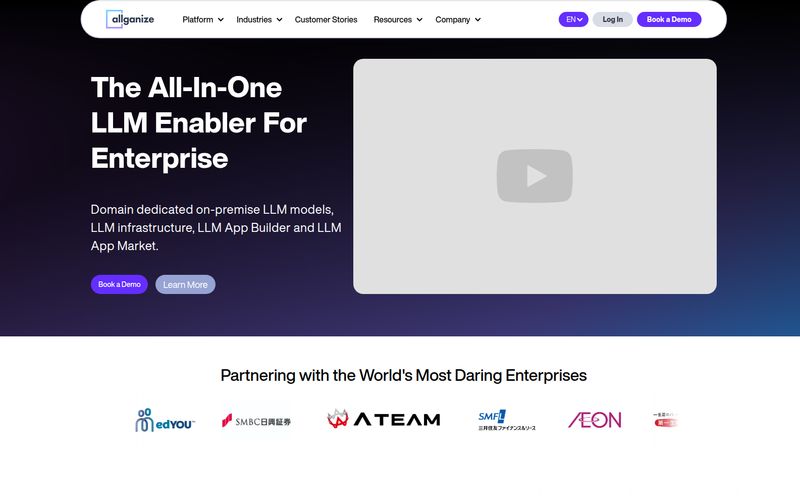In the world of SEO and traffic generation, we're constantly bombarded with the 'next big thing.' For a while, it was pop-ups. Then it was push notifications. Now, the new kid on the block that everyone’s talking about is the AI chatbot. And honestly? Most of them are either ridiculously complicated or just… bad. Clunky, robotic, and more likely to frustrate a visitor than convert them.
So when a tool like Choony lands on my desk, claiming to be a no-code chatbot generator that's actually easy to use, my skepticism meter goes through the roof. I’ve been burned before. We all have. But I’m also a sucker for any tool that promises to give power back to the creators, the small business owners, and the bloggers who don't have a team of developers on speed dial. So, I brewed a strong cup of coffee and decided to see if Choony was the real deal or just another piece of vaporware.

Visit Choony
So, What is Choony, Anyway?
Let's get the basics out of the way. Choony is a platform designed to let you build your own chatbot without writing a single line of code. The whole idea is to take the brains of a sophisticated AI (more on that later) and put it into a conversational little widget on your website. You can train it on your own data, give it specific instructions, and brand it to look like it’s a native part of your site. Think of it as hiring a 24/7 front-desk assistant who can answer questions, guide users, and capture leads, but you only have to train them once.
It's aimed squarely at people like you and me. People who understand their audience and their business but would rather spend time creating content or talking to customers than wrestling with Python scripts. It’s a bridge over the technical moat that has traditionally kept AI tools out of reach for most of us.
My First Impressions: Getting Started with the Platform
Signing up and poking around was, I have to admit, surprisingly straightforward. The interface is clean. There aren't a million menus and sub-menus designed to confuse you into submission. It felt less like a complex software suite and more like setting up a social media profile. You give your bot a name, you give it instructions, and you start feeding it information.
The ‘training’ process is where the magic is supposed to happen. You can upload documents, paste text, or just write out instructions in plain English. For example, I pretended I was setting one up for my own SEO blog. I told it: "You are a friendly and helpful SEO assistant. You answer questions based on the articles on my blog. If you don't know an answer, you politely ask the user to contact me directly via the contact form." That's it. No complicated logic trees or if-then-else statements. It's a very human way to instruct a machine, which I found refreshing.
The Standout Features I Actually Care About
Okay, a clean UI is nice, but it doesn't get customers to click 'buy.' What about the features that actually move the needle?
No-Code? Seriously?
Yes. This is the big one. The term "no-code" gets thrown around a lot, but Choony seems to live up to it. If you can write an email, you can build a chatbot here. This is a game-changer because it means you can iterate fast. Got a new product? You can update your bot's knowledge in minutes. Running a special promotion? You can tweak its personality to be more sales-focused for a week. The power isn't in just building it, but in being able to easily maintain and update it without filing a ticket with an IT department.
Making It Your Own with Branding and Style
I’ve always felt that a generic, unstyled chatbot is worse than no chatbot at all. It screams “I just installed this plugin and didn’t care enough to finish the job.” It breaks user trust. Choony seems to get this. You can change the colors, the welcome message, the avatar, and all the little things that make the bot feel like yours. It’s a small detail, but it’s the difference between a tool that feels integrated and one that feels tacked on. It’s about maintaining brand consistency across every single touchpoint on your site.
The OpenAI Connection
Here’s the interesting part. Choony doesn’t have its own proprietary AI model. Instead, it hooks directly into OpenAI's API. This is both brilliant and a little bit tricky. It's brilliant because you're getting the power of the GPT models—the same technology behind ChatGPT—powering your little website bot. That's some serious horsepower. Your bot won't just be spitting back pre-programmed answers; it can understand context, have a more natural conversation, and answer questions it hasn't been explicitly trained on.
The flip side is that you need your own OpenAI API key. This means you have a separate account and billing relationship with OpenAI. It’s like buying a fantastic car, but you have to bring your own engine. For those of us in the tech space, it's not a huge deal, but it is an extra step that might trip up a complete beginner.
Let's Talk Turkey: The Real Cost of Choony
So, what's the damage? Choony operates on a freemium model. You can sign up, create a chatbot, and play around with it for free. This is great. I’m a huge advocate for try-before-you-buy. You can test its intelligence, see if you like the interface, and train it up perfectly.
However, the moment you want to actually put that chatbot on your live website—to embed it so visitors can use it—you'll need to open your wallet for a paid plan. This is a pretty standard industry practice. They give you a taste for free, and if you see the value, you subscribe. The specific pricing tiers weren't immediately available on a public page when I looked, so you'll want to check their site directly for the most current numbers. And don't forget the running cost of the OpenAI API itself, which is based on usage. It's usually pennies per conversation, but it's not zero.
The Not-So-Shiny Bits: A Few Caveats
No tool is perfect, and it would be dishonest to pretend otherwise. Let’s be real about the drawbacks. First, as mentioned, the requirement for an OpenAI API key adds a layer of complexity. It's a hurdle, albeit a small one.
Second, and this is a big one for me, the chatbots are stored on OpenAI's servers. This means if you're in a field with strict data privacy regulations (like healthcare or finance) or you're just very particular about data sovereignty, you need to think carefully. You're entrusting your conversations and potentially sensitive customer data to a third party. For my little SEO blog? Not a problem. For a law firm's website? They'd need to do some serious due diligence.
Finally, the paywall for embedding is a classic SaaS move, but it's still a limitation. You can build the world's greatest chatbot, but until you pay, it’s just a clever tool in a walled garden.
So, Who is Choony Actually For?
After playing around with it, I have a pretty clear picture of the ideal Choony user. It's not the giant enterprise with a 10-person development team. They're probably building a bespoke solution anyway.
This is for the rest of us. It's for the:
- Solo blogger who wants to provide instant answers to common questions about their content.
- Small ecommerce store owner looking to guide customers to the right product or answer shipping questions after hours.
- Consultant or coach who needs a simple way to qualify leads and book appointments through their website.
- Marketing agencies that want to quickly deploy branded chatbots for their clients without a massive technical overhead.
If you're comfortable with new tech but don't want to get your hands dirty with code, Choony is sitting in a very sweet spot.
The Final Verdict
So, is Choony worth your time? In my opinion, yes. It successfully lowers the barrier to entry for a genuinely useful piece of AI technology. It takes something complex—training and deploying a smart chatbot—and makes it accessible. The platform is straightforward, the branding options are solid, and the power of OpenAI under the hood is undeniable.
The caveats are real—the API key requirement and the data storage situation are things to be aware of—but they aren't deal-breakers for the majority of potential users. The ability to test it out with a free trial means you have literally nothing to lose by giving it a spin. Go build a bot. Train it. Talk to it. See if it feels right for your brand. You might be surprised at how capable your new digital assistant can be.
Frequently Asked Questions about Choony
- Do I need to know how to code to use Choony?
- Absolutely not. That's its main selling point. It's a completely no-code platform. If you can fill out a form and type instructions, you have all the skills you need.
- Can I really use Choony for free?
- Yes, you can. There is a free plan that allows you to create and train your chatbot. However, to embed the chatbot on your own website for visitors to see and interact with, you will need to upgrade to one of their paid plans.
- How 'smart' is a chatbot made with Choony?
- Because Choony uses the OpenAI API, your chatbot's intelligence is powered by the same models behind tools like ChatGPT. This means it's very capable of understanding natural language, remembering context within a conversation, and providing nuanced answers beyond a simple script.
- Where is my chatbot's data and conversations stored?
- This is an important point. The chatbots and their conversation data are stored on OpenAI's servers, not on Choony's or your own. You should consider the privacy and security implications of this for your specific business needs.
- What do I need to get started?
- You'll need to sign up for a Choony account and have an OpenAI API key. You can get an API key by creating an account on the OpenAI platform. Be sure to have some content or information ready to train your bot with!
References and Sources
- OpenAI API Information
- (Note: A direct link to Choony's website would be placed here once available.)



